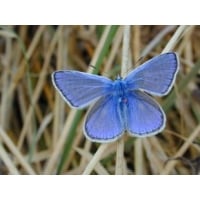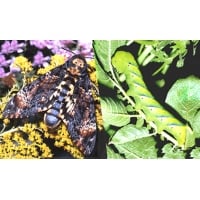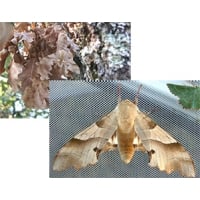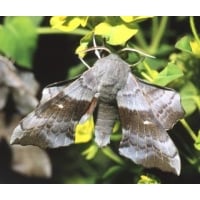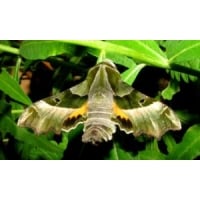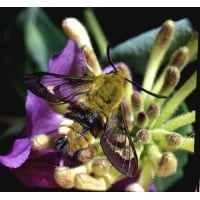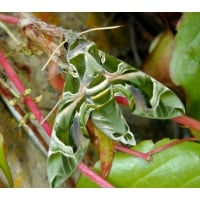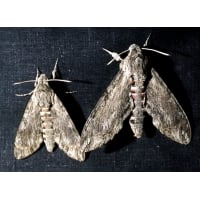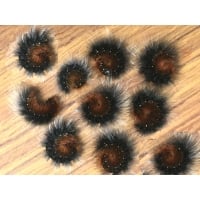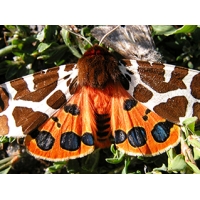Current EGGS and LARVAE
If you are a beginner and need information on rearing from small caterpillars, or hatching out pupae, please order the All Colour Paperback BUTTERFLIES. INSTRUCTIONS ARE NOT SENT WITH EACH SPECIES, you need to acquire basic skills and this book is a simple way of doing so.
The Common Blue Polyommatus icarus
This Blue is probably the most wide-spread of all the Blues. The bright sky-blue of the male is familiar to most people. The larvae feed on Birdsfoot Trefoil, Medick, Rest Harrow and other Leguminosae.
The larvae are very small. If you are not an experienced breeder it would be better to choose one of the easier species to rear.
Deathshead Hawkmoth Acheronia atropos
For international destinations larvae will be sent because eggs develop too quickly in warm weather.
Everyone’s favourite. In a massive operation most booked orders have now been supplied, and we can now supply new orders. An extreme rarity, migrating to Britain from Africa. Occasionally the larvae are found in potato fields but that’s if you are lucky and these days with modern machinery the chances of larvae being found are even more remote. Due to travel restrictions there is a world shortage of Deathshead in captivity, but our breeders now have superb wild stock, which is being very productive. Orders for pupae will be supplied this summer, as well as eggs and larvae now.
The larvae feed on many plants in the potato family, Solanaceae, but you don’t have to have these to keep the larvae: they do well on Privet. They have also been found feeding on Buddleia, resulting in a pale coloured larva that matches the leaves, but this is not a recommended foodplant.
The duration of the egg stage is just a few days, and the larvae grow probably twice as fast as our native hawkmoth larvae, completing their life cycle in as little as 4-6 weeks in summer temperatures. These larvae will produce another generation of moths within weeks of pupation, but you can keep them cool in the winter months, and have them emerge in spring.
The moth is just amazing to have alive on your hand! It is furry, and squeaks – almost like handling a little mammal. It also humps its back and displays the blue markings on the body, as well as the famous skull and crossbones on the thorax. The moth needs to feed, not from flowers but from a pad soaked in weak honey or sugar solution. Moths have been found inside beehives, attracted by the sweet smell of honey.
In summer, the pupae will emerge within about 4 weeks. In autumn, to overwinter, bury the pupae in light compost that is not too damp but not allowed to dry out. The top of each pupa should be just showing. Store in a cool place (10-15 degrees C) away from predadors. Bring into the warm in April ready for May emergence.
Oak Hawk Marumba quercus
A very special European rarity. A much sought after species. The larvae feed on Oaks, with a preference for Evergreen Oaks. Pupae pass the winter and emerge in summer.
Young larvae eat their own egg shell on hatching. They don't take leaf until they have made the first skin change!
Click on picture of dried Oak leaves to see remarkable camouflage
Geranium Bronze Butterfly Cacyreus marshalli
A South African Lycaenid, a tailed Blue, the first time offered by WWB. The larvae feed on Geranium and Pelargonium, wild and cultivated, mainly in the flower buds but also the leaves. The species first appeared in Europe around 1990 and has spread around much of the Mediterranean, but also found in summer further north. There is apparently no dormant stage, but it is considered that it cannot survive in the wild in places where the winter is cold. This is an opportunity to try a new species and learn more about it.
Poplar Hawkmoth Laothoe populi
Fast growing, the larvae feed on most Willows and Poplars. They do well in sleeves or caged.
This is one of the few hawkmoths that produce two broods of moths in the year.
The larvae become very fat and vary in both the ground colour, in shades of green or blue/green, and in their markings which often include red spots as well as the oblique stripes down the sides.
The larvae need to burrow into compost for pupation.
Willowherb Hawkmoth Proserpinus proserpina
SCARCE! Only a few pupae available.
This rather rare Hawkmoth is a gem, seldom encountered, though it lives throughout much of western and central Europe, eastwards into Russia.
The larva is rather like a grey form of Small Elephant Hawk. The foodplant is Rosebay Willowherb Epilobium, Evening Primrose Oenothera and Purple Loosetrife Lythrum. The pretty little green moth has prominent egg-yolk coloured hindwings. The normal flight period is June and July.
Broad-bordered Bee Hawk Hemaris fuciformis Larvae
A very difficult species to obtain as eggs and larvae. Sent out in June, supplies will be limited. Larval foodplant is Honeysuckle. Not difficult to rear. Hibernation is in the pupal stage. The moth emerges with a thin layer of grey scales on the wings. Remarkably, on its first flight, the scales are shed, leaving transparent bee-like wings.
Oleander Hawk Daphnis nerii
Because the egg stage is only a few days, they cannot be supplied outside Britain.
One of the finest of all Hawkmoths. The larvae are very fast growing indeed and they consume a lot of food. It is often possible to have the larvae from hatching to pupation in little more than a month.
Larvae thrive on Privet and can be reared on Periwinkle Vinca, or Honeysuckle Lonicera. Suitable for winter or summer rearing. Oleander Nerium is a natural foodplant but it is often tough and leathery, so the alternives are usually better than Oleander.
Convolvulous Hawkmoth Herse convolvuli
The moths have started breeding. Larvae will follow next month. Not available every year: these are very special!
Huge caterpillars: fascinating to rear. The pupa has a curious proboscis, like a jug handle. Feeds at dusk, Tobacco plants, Petunia, Lillies and Phlox.
Larval Foodplants: Convolvulus, Field Bindweed, Hedge Bindweed, some Morning Glories.
Best reared in Plastic Rearing Containers: see the advice at the heading of that section of the WWB website. Keep at about 25 degrees C. The paper lining and food must be changed EVERY day. Food needs to be very fresh at all times. When larger the larvae may need this change twice a day, due to their productivity!
Larvae pupate in deep compost. Amazing pupae with jug-handle exterior proboscis case!. The pupae may be held cool until next season or incubated to produce moths in a month or two.
Garden Tiger Moth Arctia caja
Young larvae that in the wild would hibernate and if kept warm and active, could develop and produce another generation this year. If young larvae are released into hedgerows, there is the opportunity to introduce Woolly Bears back into the countryside, where once they were abundant each spring.
Garden Tiger larvae Woolly Bears grow fast on Dock, Dandelion, Dead Nettle, Nettle and many other hedgerow plants, also Pussy Willow Salix caprea and Osier Willow Salix viminalis. You can also feed them conveniently on Cabbage.
Now a most difficult species to obtain.
In the wild, late summer larvae would hibernate, but if you keep them warm and light, many will produce another generation this year.
If you wish to hibernate Wooly Bears, sleeve them in autumn on Willow or Sallow (Pussy Willow). The falling leaves curl to form a ventilated ball in which the larvae hibernate. If all goes well in winter the larvae emerge in spring and feed from the new spring leaves.
Garden Tiger Moth Arctia caja 50 larvae
The price for 50 Woolly Bears has been substantially reduced to encourage releasing in the wild.
Children love them!
Garden Tiger larvae Woolly Bears grow fast on Dock, Dandelion, Dead Nettle, Nettle and many other hedgerow plants, also Pussy Willow Salix caprea and Osier Willow Salix viminalis. You can also feed them conveniently on Cabbage.
Now a most difficult species to obtain.
These are spring and summer larvae. In the wild, late summer larvae would hibernate, but if you keep them warm and light, many will produce another generation this year.
If you wish to hibernate Wooly Bears, sleeve them in autumn on Willow or Sallow (Pussy Willow). The falling leaves curl to form a ventilated ball in which the larvae hibernate. If all goes well in winter the larvae emerge in spring and feed from the new spring leaves.
From October to spring the larvae are in hibernation. Orders are booked for dispatch when the larvae awake and feed.
Lappet Moth Gastropacha quercifolia
We don't get Lappets every year. This is quite special.
A magnificent species with fascinating, very large furry caterpillars that blend into their surroundings, and a moth that looks just like a bunch of leaves. Very easy to rear, sleeved on growing Blackthorn, Plum, Hawthorn or Apple.
The larvae grow to become a good size for hibernation, when they settle down the twigs and remain still for the winter.
Sleeve the larvae for the winter, using a double sleeve which protects better than single, during winter gales and helps prevent predators. In spring they awake and feed up rapidly, becoming giant and pupating in June. The cocoon is thin and papery. Inside the pupa is fragile and should not be disturbed. The moth is something that will amaze anyone seeing it for the first time!

